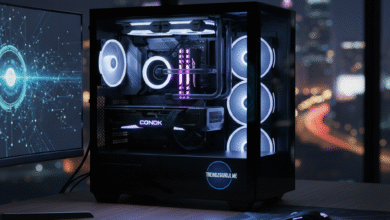Understanding SMT Line and PCBA: Essential Components of Modern Electronics Manufacturing

In the world of electronics manufacturing, Surface Mount Technology (SMT) lines and Printed Circuit Board Assembly (PCBA) are fundamental elements that drive the production of modern electronic devices. These processes are essential for creating high-quality, efficient, and reliable electronic components that meet the demands of industries such as consumer electronics, automotive, medical, and aerospace. This article will delve into the importance of SMT lines, the role of PCBA, and how these two components together form the backbone of electronics manufacturing.
What is an SMT Line?
An SMT (Surface Mount Technology) line is a highly automated assembly line where electronic components are mounted directly onto the surface of printed circuit boards (PCBs). SMT lines are preferred over traditional through-hole technology because they offer faster production times, greater component density, and improved reliability. SMT lines have become an industry standard, allowing manufacturers to create compact, lightweight, and high-performance electronic devices.
Key Components of an SMT Line
An SMT line typically includes several key machines and processes that work together to assemble electronic components:
1. Solder Paste Printer: This machine applies solder paste to the PCB surface, ensuring that the paste is accurately deposited onto the areas where components will be placed. A stencil often used to achieve precise alignment and thickness.
2. Pick and Place Machine: The pick and place machine is one of the most important components of the SMT line. It automatically picks electronic components from reels or trays and places them onto the PCB according to a pre-programmed layout. This machine can work at incredibly high speeds, placing thousands of components per hour.
3. Reflow Oven: After components are placed on the board with solder paste, the PCB moves into a reflow oven. Here, the board is gradually heate, causing the solder paste to melt and bond the components to the board. The reflow process carefully controlled to avoid damaging sensitive components.
4. Automated Optical Inspection (AOI): The AOI machine uses cameras and sensors to inspect each PCB for defects, such as missing components, incorrect placement, or soldering issues. This process is essential to maintaining high quality and reducing errors in the final product.
5. Conveyor Systems: These transport the PCBs from one machine to another, facilitating smooth and efficient movement along the SMT line.
Benefits of Using an SMT Line
• High Efficiency and Speed: SMT lines are highly automated, enabling rapid and consistent production. This is especially important for high-volume manufacturing.
• Improved Component Density: Surface mount components are much smaller than through-hole components, allowing for more compact designs and higher component density on the PCB.
• Cost-Effective Production: SMT lines reduce manual labor and minimize errors, leading to more cost-effective production.
• Enhanced Product Reliability: The precision and control in SMT lines improve the reliability and durability of the assembled PCBs.
The Role of PCBA in Electronics Manufacturing
PCBA, or Printed Circuit Board Assembly, is the process of populating or assembling a PCB with electronic components to create a functional circuit. The PCBA process involves several stages, including component placement, soldering, and inspection. SMT lines are an integral part of the PCBA process, as they handle the placement and soldering of components onto the PCB.
PCBA Process Overview
1. Design for Manufacturing (DFM): Before assembly begins, the PCB design undergoes DFM analysis to ensure it is optimized for manufacturing. This step helps identify potential issues early, saving time and cost.
2. Component Sourcing: High-quality components are sourced from reliable suppliers. These may include resistors, capacitors, ICs, connectors, and more, depending on the design and application of the PCB.
3. Assembly with SMT Line: In most cases, the assembly process is carrie out on an SMT line, where components are precisely placed and soldered onto the PCB. This automated assembly is fast, accurate, and ensures consistent quality.
4. Inspection and Quality Control: After assembly, the PCBs undergo a range of quality control inspections. In addition to AOI, other inspection methods such as X-ray inspection and In-Circuit Testing (ICT) may be us, depending on the complexity and requirements of the board.
5. Functional Testing: To verify that the assembled PCB functions correctly, functional testing is performe. This step ensures that the board meets all design specifications and can operate effectively in real-world applications.
6. Packaging and Shipping: Once tested, the PCBA boards are package and shipped to customers or to the next stage of production, depending on the product.
Why PCBA is Crucial for Modern Electronics
• Core of Electronic Devices: PCBA is the foundational building block of any electronic device. It brings together all components needed to perform the device’s intended functions.
• Versatility Across Industries: PCBA is us in various industries, from automotive and medical to consumer electronics and aerospace. Its flexibility allows for the creation of customized solutions for each application.
• Precision and Quality Assurance: The PCBA process is design to deliver reliable and high-quality products. This precision is crucial in sectors where safety and performance are paramount, such as in medical and aerospace applications.
SMT Line and PCBA: A Perfect Pair in Electronics Manufacturing
The integration of SMT lines into the PCBA process represents a significant advancement in electronics manufacturing. By automating the assembly of components, SMT lines enhance the efficiency, quality, and speed of the PCBA process. Together, SMT lines and PCBA enable manufacturers to produce complex electronic products that meet the demands of today’s technology-driven world.
Advantages of Using SMT Lines in the PCBA Process
1. Reduced Manual Labor: Automation in SMT lines minimizes the need for manual intervention, reducing labor costs and human error.
2. Higher Throughput: SMT lines are capable of placing thousands of components per hour, which is essential for high-volume production.
3. Enhanced Consistency and Precision: The automation provided by SMT lines ensures each PCB is assemble with consistent quality and accuracy.
4. Reduced Production Time: The speed and efficiency of SMT lines significantly reduce the overall production time for PCBA, allowing manufacturers to meet tight deadlines and customer demands.
Choosing the Right SMT Line and PCBA Provider
Selecting the right SMT line and PCBA provider is crucial for achieving high-quality results. Here are some factors to consider:
• Experience and Expertise: Look for providers with experience and technical expertise in SMT and PCBA. An experienced provider will have the knowledge to handle complex designs and ensure high standards.
• Quality Control Processes: A reputable provider should have stringent quality control measures in place, such as AOI, ICT, and functional testing, to ensure the final product meets specifications.
• Advanced Equipment: Choose a provider that invests in advanced SMT equipment, as this will directly impact the quality and speed of the assembly process.
• Scalability: It’s important to work with a provider that can scale production based on demand, whether for small prototypes or large-scale manufacturing.
Conclusion
The synergy between SMT lines and PCBA has revolutionized the electronics manufacturing industry, making it possible to produce complex, high-quality electronic devices efficiently and cost-effectively. SMT lines streamline the component placement and soldering stages, while PCBA integrates these components into a functional assembly, bringing the design to life. With China as a global leader in this space, businesses have access to a vast array of SMT line and PCBA services, ensuring reliable, affordable, and innovative electronics manufacturing solutions.
Whether for consumer electronics, automotive systems, medical devices, or aerospace applications, SMT lines and PCBA continue to be at the heart of technological progress, driving innovation and setting new standards in the electronics industry.



